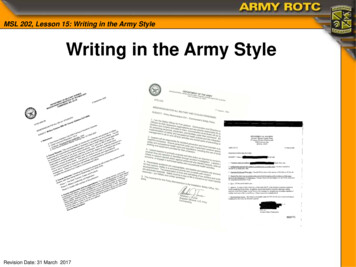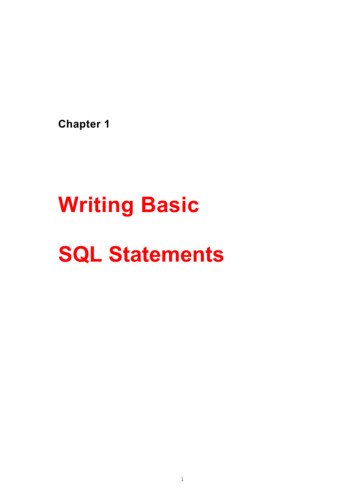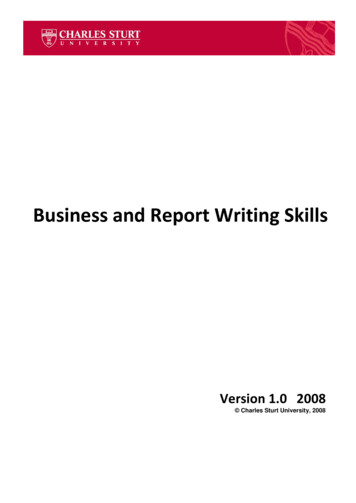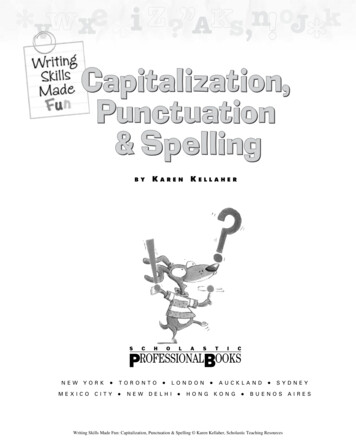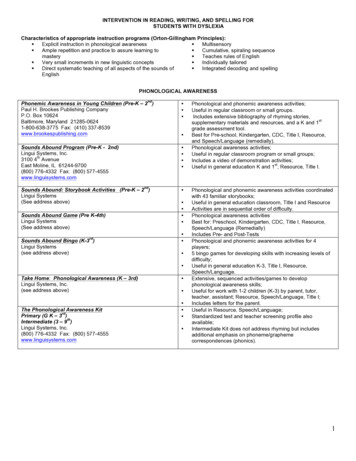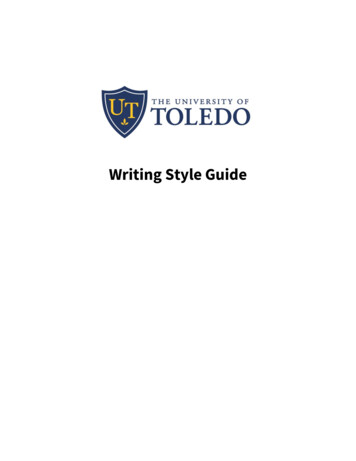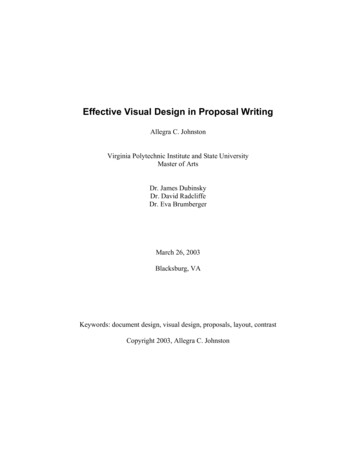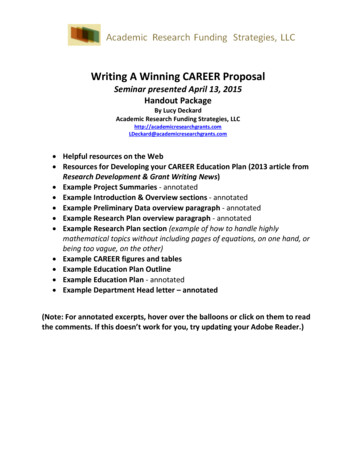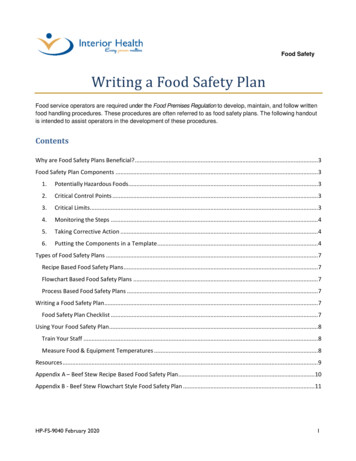
Transcription
Food SafetyWriting a Food Safety PlanFood service operators are required under the Food Premises Regulation to develop, maintain, and follow writtenfood handling procedures. These procedures are often referred to as food safety plans. The following handoutis intended to assist operators in the development of these procedures.ContentsWhy are Food Safety Plans Beneficial? . 3Food Safety Plan Components . 31.Potentially Hazardous Foods. 32.Critical Control Points . 33.Critical Limits. 34.Monitoring the Steps . 45.Taking Corrective Action . 46.Putting the Components in a Template . 4Types of Food Safety Plans . 7Recipe Based Food Safety Plans . 7Flowchart Based Food Safety Plans . 7Process Based Food Safety Plans . 7Writing a Food Safety Plan . 7Food Safety Plan Checklist . 7Using Your Food Safety Plan . 8Train Your Staff . 8Measure Food & Equipment Temperatures . 8Resources . 9Appendix A – Beef Stew Recipe Based Food Safety Plan. 10Appendix B - Beef Stew Flowchart Style Food Safety Plan . 11HP-FS-9040 February 20201
Appendix C: Food Safety Plan Templates and Log Sheets . 12“No – Cook” Plan - for potentially hazardous foods / menu items . 13“Cook – (Hold) - Serve” Plan - for potentially hazardous foods / menu items . 14“Cook – (Hold) - Serve” Plan with Leftovers - for potentially hazardous foods / menu items . 15“Cook – Chill - Serve” Plan - for potentially hazardous foods / menu items . 16“Cook – Chill - Reheat - Serve” Plan - for potentially hazardous foods / menu items. 17Temperature Monitoring Log (Multiple Units) . 18Temperature Monitoring Log (Single Unit with Corrective Action) . 19Cooling Log . 20Time/Temperature Log for Catered Events . 21HP-FS-9040 February 20202
Why are Food Safety Plans Beneficial?A food safety plan contains written procedures that staff use to safely prepare food. The benefits of theplan are to: reduce the risk of a foodborne illnessensure that food is handled in a consistent mannerassist with employee traininghelp reduce food waste in the establishmentallow staff and management to control and maintain food safetyA basic Food Safety Plan uses the "HACCP" method. HACCP stands for "Hazard Analysis - Critical ControlPoints". For the food safety plans to be effective, you will also need to ensure you are following best practicesin your standard operating procedures. These are often called “prerequisite programs”.Food Safety Plan ComponentsThere are some standard steps or components that are common to food safety plans. Each is important tohelp guide food handlers using the plan in identifying what the most important steps are, how they need to bechecked, what is the limit for safety and what actions to take if the limits are not met.1. Potentially Hazardous FoodsDescribe the procedures to follow when handling any potentially hazardous foods that are served inyour establishment. Potentially hazardous foods are those that are capable of supporting thegrowth of disease-causing microorganisms or the production of toxins. These are usually foods thatare considered perishable. Examples:-Foods of animal origin (meat, fish, dairy, eggs, etc.)Foods of plant origin (vegetables, fruits, etc.) that have been cut or cookedRaw seed sprouts (alfalfa, bean sprouts, radish sprouts, etc.)Cooked starches (pasta, rice, etc.)Soybean proteins (soy milk, tofu, etc.)2. Critical Control PointsFor each potentially hazardous menu item, create a food safety plan using a step-by-step procedurethat identifies the critical control points.Critical Control Points (Critical Steps): A Critical Control Point (CCP) is a step in the preparationprocess where a food safety hazard can be controlled. Subsequent steps in the preparation processwill not eliminate the hazard if it is not controlled at this point. Some items will have more than oneCCP.Clearly identify these steps for each potentially hazardous food item. Examples of CCPs:- receiving- storage- preparation- cooking- hot holding- cooling- reheatingNot all steps are always considered critical. Some may be considered critical steps for some menuitems, but not other menu items. It depends on how the item is prepared.3. Critical LimitsCritical Limit (Food Safety Standard): A Critical Limit is a measurable standard or limit that must bemet to control the food safety hazard at a Critical Control Point. Examples:HP-FS-9040 February 20203
-cold storage temperature of 4 C or lessfinal cook temperature of 74 Chot holding temperature of 60 C or morecooling food from 60ºC to 20 C in 2 hours and 20 C to 4 C in 4 hours4. Monitoring the StepsDescribe how you will ensure that the critical limits are adhered to. Monitoring can include measuringan internal temperature, visually assessing food, or observing practices.5. Taking Corrective ActionDetermine action(s) required when a critical limit is not met. The corrective action must eliminate thehazard or reduce it to an acceptable level. Some examples:cook the product longerreheat the productdiscard the product6. Putting the Components in a TemplateAn example plan is shown below that outlines typical steps in the food preparation process. Eachstep shows the critical control points, potential hazards, critical limits, monitoring procedures andcorrective cal Limits(Food Safety Standards)MonitoringProceduresCorrective ActionsReceivingContaminationof foodFood is obtained fromapproved sourcesVerify withsupplier if indoubtReturn unsuitable foodto the supplierRefrigerated foodtemperature is4 C or less upon receiptChecktemperature offood and recordReturn unsuitable foodto the supplierFood is wholesome, free ofpests; packaging isundamagedVisually inspectfood andpackagingReturn unsuitable foodto the supplierPerishable food is stored at4 C or lessChecktemperature offood/cooler andrecordAdjust temperaturesetting or service theunitGrowth ofpathogensStorageGrowth ofpathogensStore frozen food at -18 Cor lessThaw frozen food: In cooler/refrigerator Under cold runningwater In microwave, justprior to useHP-FS-9040 February 2020Checktemperature offood/cooler andrecordObserve thawingpracticeMove food to alternatestorage unit;Discard food heldabove 4 C for morethan 2 hoursModify practices;discard contaminatedfood4
CriticalControlPointsPotentialHazardsCritical Limits(Food Safety Standards)MonitoringProceduresCorrective ActionsStorage(continued)Contaminationof foodChemicals are storedbelow, away and separatelyfrom food itemsFoods are covered withplastic wrap or food gradematerial to preventcontaminationOpen canned foods aretransferred into food gradecontainers.Open bags of food areresealed after use or storedin pest proof containers.VisuallyinspectfoodstorageareasModify practices;Discard potentiallycontaminated foodPreparationContaminationof foodSanitize food contactsurfaces and equipmentprior to useObservepracticesModify practices;discard contaminatedfoodPractice good employeehygiene: No ill employees Frequent hand washing Cuts, burns andabrasions treated andcovered Clean clothing worn Hair restrained No jewelry Clean fingernailsRequire rewashing ofhands if necessaryObserve StaffIll workers to beassigned non-foodhandling duties orexcluded from workCookingSurvival ofpathogensCook food to an internaltemperature of: 74 C Other established safecooking temperature*Check internaltemperature atthe thickest partof the foodContinue cooking untilthe required internalfood temperature isreachedHot HoldingGrowth ofpathogensHold potentially hazardousfoods at or above 60 CCheck internaltemperature atthe thickest partof the food andrecordtemperatureAdjust temperaturesetting or service unit;Move food to alternatestorage unit;Discard food that isheld at less thano60 C for more than2 hours discardfood.HP-FS-9040 February 20205
CriticalControlPointsPotentialHazardsCritical Limits(Food Safety Standards)MonitoringProceduresCorrective ActionsCoolingGrowth ofpathogensCool foods:Check internaltemperature ofthe food atvarious timesduring cooling;use a timer toensure that foodis cooled withinthe appropriatetimeframeDiscard food heldabove 21 C but lessthan 60 C for morethan 2 hoursCheck internaltemperature atthe thickest partof the foodContinue cooking untilthe required internalfood temperature isreached60 C to 20 C in 2 hours;then from20 C to 4 C in 4 hours;Total cooling time shouldbe 6 hours or lessCooling methods: Use shallow storagecontainers Use an ice bath Use an ice wand Wait until food is coldbefore coveringReheatingSurvival ofpathogensReheat foods to 74 Cwithin 2 hoursDiscard food heldabove 4 C but lessthan 21 C for morethan 4 hoursDiscard food thattakes more than 2hours to reach 74 C*See resources for further information on alternative cooking temperaturesHP-FS-9040 February 20206
Types of Food Safety PlansThere are three types of food safety plans that can be used to control food safety hazards in yourestablishment, recipe, flow chart and process based.Recipe Based Food Safety PlansRecipe based food safety plans incorporate the food safety plan components into a standard recipe.Additional information, such as sanitation instructions can also be added if necessary.See Appendix A for an example using the Beef Stew Recipe in the Ensuring Food Safety book.Flowchart Based Food Safety PlansFlowchart based food safety plans are often used in food manufacturing. They provide excellent detail,but a separate flowchart is required for each item. This can be a challenge in establishments where themenu changes on a regular basis.An example of the Beef Stew recipe using a flow chart based food safety plan is shown in Appendix B. Atemplate is included at the end of this handout.Process Based Food Safety PlansThe process based food safety plan involves grouping together menu items that are processed in thesame way. One plan can be applied to a number of different menu items. Some of the commonprocesses used to prepare foods include: No Cook: items such as salads, sandwichesCook – Serve: items such as steaks, burgers, chicken stripsCook – Chill – Serve: items such as potato salad, chicken saladCook – Chill – Reheat – Serve: items such as soups, pasta sauceProcess based food safety plan templates are included at the end of this handout.Writing a Food Safety PlanChoose the type of plan that is the easiest for you to use. Regardless of the style, the process fordeveloping the plan is the same.1. Review your menu and identify all of the potentially hazardous items2. For each item identify the: critical control points critical limit(s) for each critical control point monitoring steps required for each critical limit corrective actions required if a critical limit is not met3. Include any other information necessary to control food safety hazards4. Once you have the plan completed, use the checklist:Food Safety Plan Checklist Does the food safety plan include all the potentially hazardous foods? Does the plancontent match the menu?HP-FS-9040 February 20207
Are the CCPs included and appear correct? Are the critical limits included, measurable, and specific? Are the monitoring steps included in the food safety plan and are they reasonable? Doemployees have the tools needed to monitor? Are the corrective actions outlined for each CCP and are they appropriate to control thehazard?5. Fill in the templates and log sheets for your plan. There are various types provided in Appendix C.You only need to prepare one type of food safety plan.Using Your Food Safety PlanTrain Your StaffOnce your food safety plan is complete the next step is to put it into action. Use it to train food handling staff,update the plan when changing recipes and have food handling staff review and refer to it regularly.Measure Food & Equipment TemperaturesUse a calibrated thermometer to measure food temperatures. The following table suggests testingfrequencies for different steps:Storage & HandlingCoolersTesting Frequency1x per day or moreCommentsndRegularly check built in thermometers against a 2thermometer known to be accurate (i.e. recentlycalibrated)Cold-holding1x per day or moreCheck cooling inserts and foods held on iceHot-holding1x per day or moreRandomly check 1 food item in each holding unit 2hours after commencement of hot-holdingCoolingEvery 2-3 monthsCheck cooling methods for each food when FoodSafety Plan is first started*Cooking/Re-heating1x per monthCheck cooking and reheating methods for each fooditem when Food Safety Plan is first implemented** If the recipe or volume of a food is altered, cooking & cooling methods need to be re-testedIf a problem is discovered, take immediate action to correct it.We recommend recording both temperatures and any corrective actions taken. Log sheets are includedat the end of this handout to assist with record keeping. W e suggest keeping temperature records forthree months.Review the food safety plan periodically to ensure that it is complete and matches the menu.Specialty foods or styles of preparation such as sous-vide, confit, raw seafood, fermented foods, in housecanning and bottling require a more detailed Food Safety Plan. Consult with your Environmental HealthOfficer.For additional Food Safety resources and templates please 040 February 20208
Resources1. Ensuring Food Safety-Writing Your Own Food Safety Plan the HACCP Way, BCCDC uals/EH/FPS/Food/EnsuringFoodSafetyHACCPWay.pdf2. Food Retail and Food Services Code, CFISIG de.pdf3. Managing Food Safety: A Manual for the Voluntary Use of HACCP Principles for Operators of FoodService and Retail Establishments, FDA HACCP/ucm2006811.htmHP-FS-9040 February 20209
Appendix A – Beef Stew Recipe Based Food Safety PlanBeef Stew Recipe Based Food Safety PlanIngredientsStewing beef (pre-cooked)Beef stew base, Beefconsommé, Beef gravyVegetables (frozen)SeasoningWaterWeights and Measures2.5 kilograms1 can (each)2 packages1 packet5 litresPREPARING1. Pour beef stew base, beef consommé, and beef gravy into stockpot.Add water and seasoning. Stir with wire whisk until all seasoning isdissolved.COOKING2. Preheat stove. Begin heating beef stew mix.3. Break up any clumps in the frozen vegetables. Add to the beef stewmix. Stir with long-handled spoon.Critical Step4. Add cooked stewing beef and stir. Continue heating beef stew until74 C (165 F) or hotter is reached for at least 15 seconds. Simmer for30 minutes.SERVING AND HOLDING5. Serve immediately, orCritical Step6. Hold beef stew at 60 C (140 F) or hotter in hot hold unit, andcover if possible. Do not mix new product with old. Reheat to 74 C(165 F) if stew is less than 60 C (140 F) for 2 hours or less. If more than2 hours, discard.COOLINGCritical Step7. Cool in shallow pans with a product depth not to exceed 2 inches.Product temperature must reach 20 C (70 F) within 2 hours andthen reach 4 C (40 F) within 4 hours (6 hours total). Stir frequently.Discard product that is not cooled to 4 C in 6 hours.8. Store at a product temperature of 4 C (40 F) or colder in the cooler.Cover.REHEATINGCritical Step9. Reheat beef stew to a product temperature of 74 C (165 F) orhotter for at least 15 seconds within 2 hours - one time only.Sanitation Instructions:Measure all temperatures with a cleaned and sanitized thermometer. Wash hands before handling food,after handling raw foods, and after any activity that may contaminate hands. W ash, rinse, and sanitize allequipment and utensils before and after use. Return all ingredients to refrigerated storage if preparationis delayed or interrupted.HP-FS-9040 February 202010
Appendix B - Beef Stew Flowchart Style Food Safety PlanFlowchartReceiving PotentialHazardContamination;Growth ofpathogensCCPCritical LimitsMonitoringStepsChecktemperatureVisual inspection.NoPHFs must bebelow 4 C(40 F).Growth ofpathogensNoMaintain below4 C (40 F).Check food andair temperatureevery 4 hours.ContaminationNoUse of cleanutensils.Ensure allutensils andmixing pots areclean before use.Cooking PathogensurvivalYesHeat to 74 C(165 F) orhotter and holdfor at least 15secondsHolding Growth ofpathogensYesMinimumtemperature of60 C (140 F)Check stewtemperature(sanitizedthermometer)before serving/holding.Check stewtemperature inhot hold unitevery 2 hours(sanitizedthermometer).Cooling Growth ofpathogensYesReheatingPathogensurvivalYes60 C (140 F) to20 C (70 F)within 2 hoursAND then 20 C(70 F) to 4 C(40 F) within 4hoursHeat to 74 C(165 F) orhotter and holdfor at least 15seconds.Heating must bedone within 2hoursRefrigeration Preparing HP-FS-9040 February 2020Checktemperature(sanitizedthermometer) ofcooling stew.Checktemperature(sanitizedthermometer) ofheating stewevery hour.Corre
2. Critical Control Points For each potentially hazardous menu item, create a food safety plan using a step-by-step procedure that identifies the critical control points. Critical Control Points (Critical Steps): A Critical Control Point
